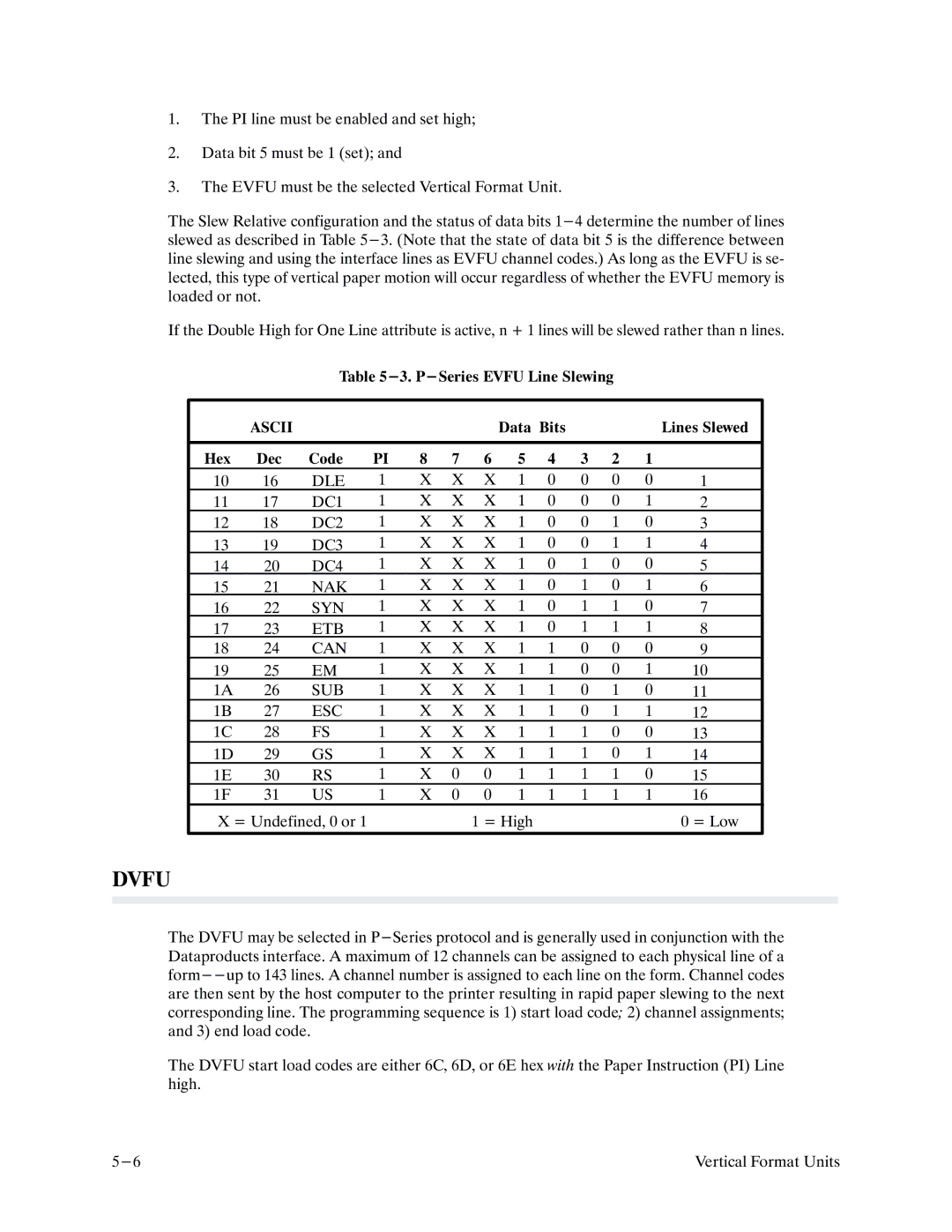1.The PI line must be enabled and set high;
2.Data bit 5 must be 1 (set); and
3.The EVFU must be the selected Vertical Format Unit.
The Slew Relative configuration and the status of data bits
If the Double High for One Line attribute is active, n + 1 lines will be slewed rather than n lines.
Table
| ASCII |
|
|
|
|
| Data Bits |
|
|
| Lines Slewed | |
|
|
|
|
|
|
|
|
|
|
|
|
|
Hex | Dec | Code | PI | 8 | 7 | 6 | 5 | 4 | 3 | 2 | 1 |
|
10 | 16 | DLE | 1 | X | X | X | 1 | 0 | 0 | 0 | 0 | 1 |
11 | 17 | DC1 | 1 | X | X | X | 1 | 0 | 0 | 0 | 1 | 2 |
12 | 18 | DC2 | 1 | X | X | X | 1 | 0 | 0 | 1 | 0 | 3 |
13 | 19 | DC3 | 1 | X | X | X | 1 | 0 | 0 | 1 | 1 | 4 |
14 | 20 | DC4 | 1 | X | X | X | 1 | 0 | 1 | 0 | 0 | 5 |
15 | 21 | NAK | 1 | X | X | X | 1 | 0 | 1 | 0 | 1 | 6 |
16 | 22 | SYN | 1 | X | X | X | 1 | 0 | 1 | 1 | 0 | 7 |
17 | 23 | ETB | 1 | X | X | X | 1 | 0 | 1 | 1 | 1 | 8 |
18 | 24 | CAN | 1 | X | X | X | 1 | 1 | 0 | 0 | 0 | 9 |
19 | 25 | EM | 1 | X | X | X 1 1 0 0 1 | 10 | |||||
1A | 26 | SUB | 1 | X | X | X | 1 | 1 | 0 | 1 | 0 | 11 |
1B | 27 | ESC | 1 | X | X | X | 1 | 1 | 0 | 1 | 1 | 12 |
1C | 28 | FS | 1 | X | X | X 1 1 1 0 0 | 13 | |||||
1D | 29 | GS | 1 | X | X | X | 1 | 1 | 1 | 0 | 1 | 14 |
1E | 30 | RS | 1 | X | 0 | 0 | 1 | 1 | 1 | 1 | 0 | 15 |
1F | 31 | US | 1 | X | 0 | 0 | 1 | 1 | 1 | 1 | 1 | 16 |
X = Undefined, 0 or 1 |
|
|
| 1 = High |
|
|
|
| 0 = Low | |||
DVFU
The DVFU may be selected in
The DVFU start load codes are either 6C, 6D, or 6E hex with the Paper Instruction (PI) Line high.
Vertical Format Units |
